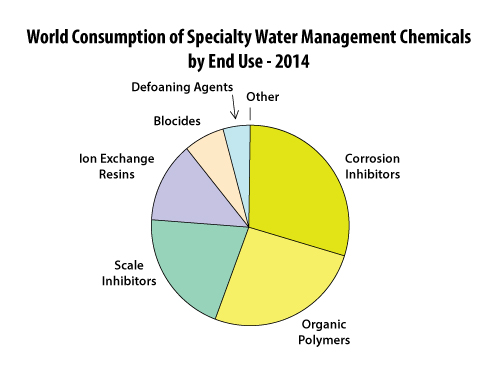

Water is a prerequisite for life on earth. Human activities are at one level or another highly dependent upon water and its broad range of uses. Freshwater is constantly renewed by nature's cycles, but at any instant less than one-100th of 1% of the planet's water is suitable and available for human use.
The global water management chemicals market is split into two major categories:
This report focuses on the market for specialty chemicals in water management. The purpose of water treatment technologies and products is to purify, supply, recycle and dispose of water. Treatment chemicals are used all along the chain from water sourcing to waste disposal. A host of technologies and products have been developed to deal with the numerous applications and wide-ranging needs consolidated under the single term water management.
The following pie chart shows world consumption of specialty water management chemicals by end use:

North America and in particular the United States, uses specialty water treatment chemicals more intensively than Europe and Japan—particularly organic coagulants and flocculants. In Europe and Japan, engineering and technical solutions are preferred when they can be used as a substitute for specialty chemicals. When chemicals are used, the less expensive commodity chemicals such as alum (aluminum sulfate), ferric sulfate, ferric chloride and polyaluminum chloride are typically used in preference to organic polymers.
In the developing world, water scarcity, coupled with inadequate sanitation and pollution controls, leaves up to half of the population of Southeast Asia and more than three-quarters of the population in some African countries without access to safe drinking water. Overall, one in three people in developing countries lacks clean water sufficient for basic needs; 80% of all diseases in these places come from contaminated water.
In industrialized countries, drinking-quality water is used for a spectrum of applications—washing cars, watering lawns, cleaning streets or cooling power stations. The failure to match adequate quality with application places a great strain on water supplies. However, gray water—municipal wastewater that has had secondary treatment—is increasingly used in the United States for irrigating golf courses and urban public green areas and for recharging lake source waters and aquifers.
Since clean water has become more difficult to find and more expensive to produce, private industry and municipalities are increasingly using water with high salt content. Both coastal (seawater) and inland sources of water with high levels of salt are increasingly being utilized. Saline water is also directly used in industrial, mining and thermoelectric power applications.
Industrial use of water can be made more efficient, for example by closing cooling water system loops, keeping all of the water from release. Recycling also has the potential to reduce the cost of raw water treatment as well as to eliminate the discharge of pollutants.
Global water management industry growth is dependent on (1) regulatory drivers, (2) industrial development requiring high-quality process water, and (3) drinking water improvement projects in part motivated by drinking water scarcity. Items 2 and 3 are most important in developing nations, particularly in China. Desalination is becoming more important in some coastal communities in the western United States and in southern Europe, but not nearly as important as on the Arabian Peninsula, and other portions of the Middle East and North Africa, where modern life depends on desalination.
Successful companies will respond to the changing needs for service and service outsourcing, as well as for chemical products and formulations. The water management market continues to have growth potential as a result of rising regulatory standards, and increasing awareness of drinking water health and purity issues in all geographic markets, but especially in developing regions.
Over the next five years, global consumption of water management specialty chemicals is expected to grow at an average annual rate of 3.2%. North American consumption is expected to grow at a rate of 2.9% per year, South America at 5.0%, Europe at about 2%, Japan at 0.8%, and China at about 6%. Consumption in the rest of the world is expected to grow at a rate of 3.5% per year.
Among the numerous trends in the water management industry are the following:
Please contact to consulting@arencochemicals.co.uk
Copyright 2015